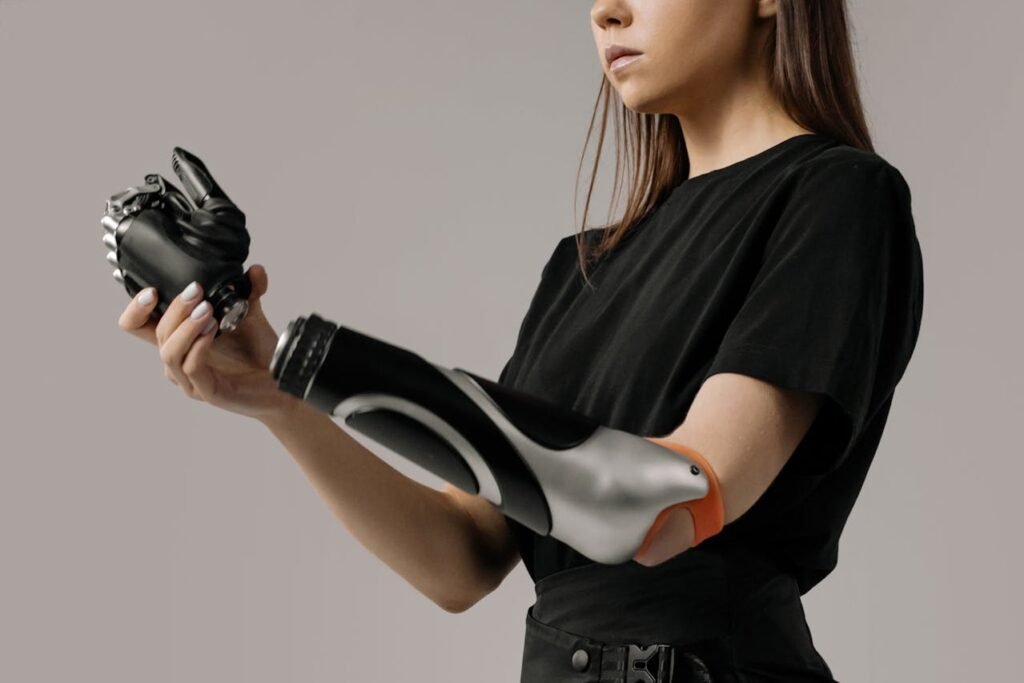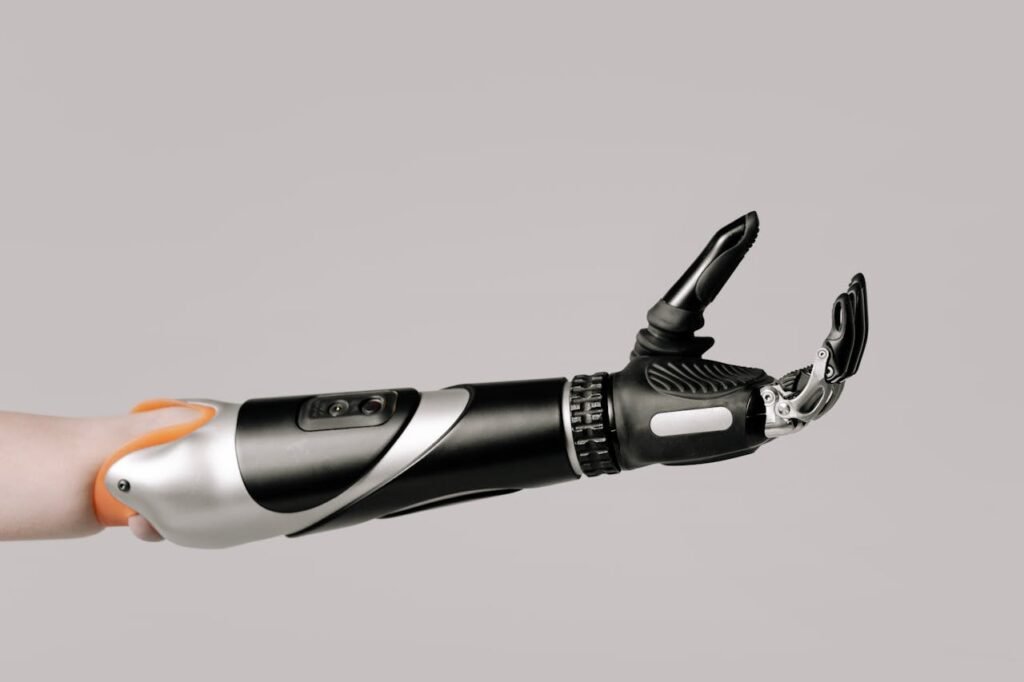In many professional spaces, silence isn’t just preferred—it’s essential. From corporate offices and classrooms to hospitals and libraries, quietness supports focus, calmness, and precision. For individuals using upper-limb prosthetics, this presents a unique challenge.
Traditional motorized prosthetic hands, while incredibly functional, can sometimes produce mechanical noise during movement. These subtle sounds—like clicks, whirs, or gear rotations—may draw unwanted attention or break concentration in quiet environments.
As prosthetic technology evolves, silent motors and discreet operating modes are transforming how users move through noise-sensitive settings. These innovations allow natural, nearly soundless motion without sacrificing grip strength, control, or comfort.
At Robobionics, we’ve seen firsthand how soundless technology improves user confidence and workplace integration. It’s not just about engineering quieter motors—it’s about restoring dignity and ease to every gesture.
In this article, we’ll explore how silent prosthetic motors work, why they matter in modern workspaces, and how thoughtful design ensures comfort, performance, and quiet confidence in every move.
Understanding Noise Challenges in Work Environments for Prosthetic Users
The Subtle Sound of Everyday Movement

Every prosthetic hand, no matter how advanced, produces a small amount of mechanical sound. These sounds come from the motor, gears, and internal components that make the fingers move and grip.
In everyday settings—like walking outdoors or riding in traffic—these sounds go unnoticed. But in quiet offices, classrooms, or studios, even the faintest click or vibration can seem amplified.
For users, this can create self-consciousness. Instead of focusing on the task at hand, they might start worrying about whether others can hear their prosthetic moving. Over time, that awareness can turn into discomfort.
The Impact of Noise on Concentration
Workplaces depend on concentration. Whether it’s typing at a desk, taking patient notes, or handling delicate lab instruments, quiet environments help people stay focused.
A noisy prosthetic, though not disruptive by design, can sometimes create small distractions. The user hears every motor shift. The person sitting nearby might notice it too.
This subtle awareness can make users hesitant to use their prosthetic fully. Instead of natural, confident motion, they may begin to move cautiously, trying to minimize sound. That hesitation affects productivity and emotional comfort alike.
Social Awareness and Confidence
Sound affects not just the user’s comfort but also their social experience. Many professionals prefer their prosthetic to function quietly so that it blends naturally into their routine.
When a prosthetic is too audible, it can unintentionally draw attention during meetings, interviews, or client interactions. This focus shift can make users feel like their prosthetic defines their presence, instead of their work or personality.
Silent technology helps solve this by restoring a sense of normalcy. When movement feels and sounds natural, users regain confidence in both formal and social settings.
Emotional Effects of Mechanical Sound
The emotional response to sound is powerful. Even a faint motor whir can create tension for those who value quietness. It’s not about embarrassment—it’s about sensitivity to the environment.
Users in meditation centers, academic research labs, or hospitals often express a desire for devices that operate as silently as possible. They want technology that feels invisible, something that supports their work quietly without altering the space’s calm.
When a prosthetic hand works without noticeable noise, it offers not just technical benefit but emotional ease. The sound of silence becomes a form of confidence.
Work Environments That Require Silence
Many professional spaces are designed to be quiet. Hospitals, classrooms, libraries, design studios, recording booths, and conference rooms all depend on low noise levels for concentration and communication.
For example, in healthcare, nurses or doctors need to work without disturbing patients. In education, teachers or students using prosthetics should be able to write or gesture without mechanical interruptions.
In these spaces, even a minor hum can feel out of place. That’s why developing silent or low-noise prosthetics isn’t about luxury—it’s about necessity for inclusion and comfort.
The Indian Workplace and Cultural Sensitivity
In India, shared work environments are common—open-plan offices, co-working hubs, and classrooms often mean many people share limited space. Sound travels easily in these setups.
A prosthetic that hums or clicks may not be disruptive in a large hall, but in a close meeting room or quiet cubicle, it can feel noticeable.
Cultural awareness also plays a role. Many Indian workplaces value subtlety and social harmony. A discreet, silent prosthetic fits naturally into this setting, allowing the user to participate freely without feeling observed.
Why Sound Minimization Matters
Reducing prosthetic noise isn’t about perfection—it’s about freedom. A quieter prosthetic gives users the confidence to use their device without second thoughts.
When they don’t have to think about the sound, they can focus entirely on the work, the interaction, or the task before them. It helps remove one more barrier between them and complete inclusion.
Quiet operation also supports professional image. A discreet, efficient prosthetic hand represents refinement, both in design and in the user’s self-presentation.
The Science and Design Behind Silent Prosthetic Motors
How Traditional Motors Create Noise

Most powered prosthetic hands rely on small electric motors to move the fingers and thumb. These motors drive gears that create precise motion and grip strength. However, mechanical parts naturally generate sound.
Each time a motor spins, its internal brushes and bearings create vibrations. These vibrations travel through the casing and produce faint whirs or clicks. When amplified by hollow sockets or rigid covers, they become noticeable in quiet rooms.
Even though these sounds are minimal, they can still draw attention in workplaces where silence matters.
Brushless Motor Technology
One of the biggest advancements in reducing prosthetic noise has been the introduction of brushless motors. Unlike traditional brushed motors, brushless designs eliminate friction between moving electrical contacts.
This not only reduces wear and tear but also cuts down the small crackling noise that usually occurs when a motor starts or stops. The result is smoother, quieter movement and a longer lifespan.
Brushless motors also generate less heat, which makes them more stable in India’s warmer climates. They’re ideal for users who wear their prosthetics for long hours, especially during busy workdays.
Vibration Damping and Acoustic Shielding
Silence in a prosthetic isn’t just about the motor—it’s also about how vibration moves through the device. Engineers now use damping materials inside the prosthetic shell to absorb sound before it escapes.
Soft silicone padding or specialized polymers placed around the motor housing prevent vibration from reaching the socket. This reduces both external noise and the faint internal buzz users might feel through their residual limb.
Some designs even include layered shells that act like acoustic walls, diffusing sound the same way noise-canceling materials work in studios.
Smooth Gear Transmissions
Traditional prosthetic gears were made of metal for durability, but metal-on-metal movement produces a high-frequency hum. To counter this, modern prosthetics now use polymer-based or hybrid gears that reduce friction.
These advanced gears glide more quietly and require less lubrication. They deliver the same strength while operating almost silently.
This design shift doesn’t just reduce sound—it also makes movement smoother, especially for fine motor actions like typing, writing, or handling paper.
Intelligent Motion Control
Another breakthrough in silent prosthetics comes from smarter software. Instead of using constant-speed motors, new models use intelligent algorithms to adjust torque and movement based on activity.
When a user performs delicate tasks, the motor automatically lowers its speed and power, creating near-silent operation. During heavier tasks, it increases torque efficiently without producing extra mechanical strain or noise.
This adaptive control system ensures quiet performance without compromising grip strength. It’s like having a prosthetic that knows when to be silent and when to show its power.
Sound Frequency Optimization
Not all noise can be eliminated, but it can be tuned. Engineers analyze the frequencies most noticeable to the human ear and redesign components to move those frequencies outside the range of everyday hearing.
For instance, higher-pitched motor whines are more noticeable than low-frequency hums. By adjusting material density and movement patterns, designers shift the sound output into less perceptible ranges.
This technique creates the illusion of silence, even when minimal sound exists. It’s a sophisticated balance of physics and perception.
Compact Motor Placement
In older prosthetic models, the motor was placed near the wrist or elbow, where it was closer to the surface and more audible.
Today’s silent prosthetics use compact motors placed deeper inside the structure. By centralizing the mechanism, sound has more layers of material to travel through before reaching the outside.
This internal positioning also improves balance and reduces vibration near sensitive skin areas, making the prosthetic feel lighter and quieter at the same time.
Noise-Absorbing Coatings
Beyond the motor, the outer casing also affects sound. Hard plastics reflect vibration easily, but noise-absorbing coatings can trap and dissipate sound waves.
Some prosthetic shells now include a micro-coating that acts like a thin acoustic barrier. It softens the sound of internal components while keeping the outer surface sleek and professional.
This innovation is particularly valuable for prosthetic hands used in workspaces where even minimal sound feels amplified—like meeting rooms or hospitals.
Discreet Mode Engineering
The concept of a “discreet mode” takes silent operation a step further. It allows users to manually switch their prosthetic into a near-silent setting when needed.
In this mode, the hand limits rapid motor bursts and operates with controlled, gentle motion. It’s perfect for situations like meetings, classrooms, or patient care, where soft gestures matter more than speed.
Once the user is back in an active setting, they can switch to normal performance mode for full power and faster response.
This dual-function approach respects both professional environments and real-life versatility.
Heat and Sound Relationship
Sound and heat are closely connected in mechanical systems. The more friction a motor generates, the hotter—and louder—it becomes.
Silent prosthetics use efficient cooling systems and low-friction components to minimize both. In India’s warm summers, this makes a huge difference in comfort and performance.
By staying cool, the motor maintains consistent sound output and avoids the sudden whine that can occur when overheating. It’s a balance of engineering precision and user comfort.
Power Efficiency and Quiet Operation
Energy-efficient motors tend to be quieter because they run at stable currents without sudden bursts. Silent prosthetic hands often use microprocessors that regulate voltage smoothly.
This means each finger moves predictably and steadily, without mechanical jolts. That kind of flow is not only quiet but feels more natural for the user.
When the prosthetic uses power more efficiently, the motor doesn’t need to strain—resulting in less sound and longer battery life.
Adapting Silent and Discreet Prosthetics to Real Work Environments
Office Spaces and Corporate Settings

Modern offices are designed around focus and collaboration. The sound of a printer or a phone is acceptable, but anything repetitive or mechanical can distract people. For prosthetic users, this means their device should operate as naturally and quietly as possible.
In boardrooms or open offices, a prosthetic with silent motors allows seamless participation. You can take notes, use a laptop, or shake hands without mechanical interruptions. The goal isn’t just silence—it’s subtlety.
In corporate India, where professionalism often includes how one presents themselves, having a quiet prosthetic hand ensures confidence during presentations, interviews, and meetings. It lets your skill speak louder than your device.
Healthcare and Medical Professions
Healthcare spaces are among the most sound-sensitive environments. In hospitals, clinics, and rehabilitation centers, peace and focus are essential for patient comfort.
A nurse, therapist, or medical professional using a prosthetic needs to move silently—whether it’s adjusting equipment or taking notes beside a patient’s bed. Silent prosthetic hands support this by operating without clicks or vibrations.
In physiotherapy or diagnostic labs, where every sound may signal precision, these devices help maintain calm and professionalism. They let medical workers move naturally without drawing attention away from their care.
Academic and Research Settings
Classrooms, laboratories, and libraries all depend on quiet concentration. A prosthetic that makes subtle noise during movement can seem louder than it is in such stillness.
For teachers, students, and researchers, discreet prosthetics restore confidence. A professor can gesture naturally during a lecture without worrying about mechanical sounds. A student can write notes or turn pages freely during an exam.
In research labs, silent operation prevents interference with sensitive equipment or recording instruments. It also helps maintain the composed atmosphere vital to intellectual focus.
Creative and Design Professions
In creative spaces like design studios, art workshops, or music production rooms, silence has a different purpose—it preserves flow. Artists and designers rely on rhythm, immersion, and quiet moments of concentration.
Silent prosthetic motors make it easier to stay absorbed in the process. Whether sketching, sculpting, or handling tools, the absence of noise helps sustain focus.
In music and sound engineering, discreet prosthetics become even more valuable. Recording sessions or editing studios are designed for perfect acoustics. Even a faint mechanical sound can affect output. A silent prosthetic ensures that movement and creation happen smoothly without any background interference.
Hospitality and Client-Facing Roles
In hospitality, presentation and customer comfort are everything. For users working in hotels, restaurants, salons, or customer service roles, quietness equals grace.
A silent prosthetic hand allows tasks like serving, arranging items, or greeting guests to appear smooth and natural. It blends into the professional atmosphere rather than standing out.
For Indian professionals in client-facing positions, discretion helps maintain trust and ease during interactions. The technology should work quietly in the background while you focus on the human connection.
Performing Arts and Media
Performers, actors, anchors, and stage professionals rely heavily on body language. A prosthetic with silent motors ensures fluidity during live performance or recording.
It allows expressive gestures and natural motion without breaking immersion. For stage actors or TV presenters, even subtle sounds can be picked up by microphones. Discreet operation ensures technical perfection meets artistic emotion.
This opens new opportunities for inclusion in the arts, where prosthetics no longer need to be hidden—they simply integrate into the craft.
Remote and Digital Work
Many professionals today work from home or hybrid spaces where microphones and cameras pick up ambient sounds easily. A noisy prosthetic might interfere with virtual meetings or recorded sessions.
Silent prosthetics eliminate that concern completely. They make online collaboration easier, letting users type, gesture, and move naturally during video calls.
As India embraces remote work more deeply, silent prosthetic technology ensures that professional engagement remains fluid and free from distractions—both for the user and their audience.
Religious, Cultural, and Ceremonial Environments
In places of worship, meditation centers, or cultural gatherings, silence carries deep spiritual and social meaning. A prosthetic that moves quietly allows participation without breaking the sacred stillness.
For women wearing traditional attire like sarees or salwar, or men attending temple rituals or community events, discreet operation keeps focus on the moment, not the machinery.
This harmony between faith, culture, and technology reflects how advanced prosthetic design can respect personal values as much as physical needs.
Adapting to India’s Work Diversity
India’s workforce is remarkably diverse. From the calm of a hospital to the noise of a construction site, every environment has different acoustic demands.
A prosthetic suited for quiet offices might need different tuning for manufacturing or agriculture. Modern designs offer adjustable modes, allowing users to control motor speed and torque to match their surroundings.
This adaptability makes silent prosthetics not only sophisticated but practical for real Indian life. They can be delicate in a lab and firm in the field—all at the turn of a switch.
Reducing Fatigue and Enhancing Focus
Noise isn’t just an environmental issue—it also affects the user internally. Constant low-level sound can cause mild sensory fatigue over time.
When a prosthetic operates silently, users experience less cognitive load. Their mind stays clear, allowing them to focus better on tasks.
This benefit is particularly significant for professionals with long work hours, such as doctors, teachers, and engineers. Quiet prosthetics don’t just protect the environment—they protect mental clarity.
Communication Without Distraction
Human communication relies on small cues—eye contact, tone, and hand movement. In quiet settings, any mechanical sound can break the natural rhythm of conversation.
A discreet prosthetic hand ensures that gestures feel authentic. Whether you’re explaining a concept in a meeting or expressing empathy during a discussion, the silence helps preserve emotional tone.
It’s not just a technical advantage—it’s a social one, helping build better understanding between people.
Integration with Indian Corporate Design
As Indian offices evolve, ergonomic and inclusive design is becoming a priority. Companies are adopting quieter workspaces with sound-absorbing materials and open layouts.
In such modern environments, a silent prosthetic fits perfectly. It aligns with the growing emphasis on accessibility, professionalism, and subtlety.
Employers and colleagues appreciate the ease it brings to interaction, strengthening inclusion through design rather than policy.
Supporting Accessibility Standards
Global workplaces are increasingly emphasizing accessible design. In India, this movement is gaining momentum. Silent prosthetics align with accessibility goals by offering equal opportunity for comfort, participation, and professionalism.
When workplaces become noise-sensitive and inclusive, they encourage individuals with prosthetics to contribute confidently without worrying about standing out.
This balance of empathy and technology shapes the future of inclusive employment in India’s fast-growing economy.
Innovation, User Experience, and the Future of Silent Prosthetics in India
The Shift Toward Human-Centered Design

The future of prosthetic technology lies in human-centered design—engineering that starts with the user’s daily experience. Silent prosthetic motors are a result of this mindset. They were not created merely to reduce decibel levels, but to restore peace, privacy, and comfort.
When engineers listen to users, they discover the emotional value of silence. It’s not just about avoiding distraction. It’s about helping someone walk into a room, work confidently, and communicate without being defined by their device.
At Robobionics, our focus has always been to design prosthetics that respond to how Indian users actually live. From crowded trains to quiet offices, the same hand must function seamlessly, adapting to every moment.
The Emotional Experience of Silence
For many prosthetic users, the first time they experience a silent motor feels transformative. There’s no hum during hand movement, no small vibration inside the socket, no sound that breaks their focus.
This quietness allows them to feel completely present—whether it’s while giving a presentation, holding a pen, or working on a computer. It’s not only technical comfort—it’s emotional release.
Silence in a prosthetic hand also removes psychological barriers. It helps users blend naturally into environments where noise can be socially or professionally awkward. It restores dignity in subtle ways that most people don’t notice, but the wearer always feels.
Inclusivity Through Subtle Engineering
Every innovation in prosthetic silence contributes to inclusivity. Discreet technology means users can fully participate in environments designed for non-prosthetic wearers—without adaptation or apology.
For example, a teacher in a classroom doesn’t have to modify her movement to avoid noise. A musician in training doesn’t need to worry about motor hum being caught on recording.
When technology becomes quiet enough to blend into normal life, it achieves true inclusion—not through visibility, but invisibility.
Custom Sound Profiles for Different Users
Just as phones and laptops have sound profiles, prosthetic systems are beginning to offer similar personalization. Some users prefer absolute silence; others may want gentle mechanical feedback to confirm motion.
This flexibility allows prosthetic hands to adapt to personal preferences and professional needs. For example, a surgeon might prefer tactile feedback without sound, while a creative professional might choose a subtle vibration cue during fine motion.
The next generation of prosthetics will likely include adjustable “noise modes,” giving users precise control over how their device interacts with their environment.
Indian Climate, Sound, and Durability
Silence in prosthetics must also survive India’s extreme climate. High heat, dust, and humidity can affect motor lubrication and acoustic insulation.
At Robobionics, our R&D focuses on ensuring silent motors remain durable even in such demanding conditions. We use temperature-stable lubricants, corrosion-resistant coatings, and vibration-damping shells tested under local conditions.
This means that a prosthetic hand designed for India stays quiet even during long, hot workdays or monsoon humidity. Silence must endure—not just in labs, but in life.
Combining Silence with Power
There was a time when quieter prosthetics meant weaker motors. Reducing noise often came at the cost of strength or speed. Today, that compromise is disappearing.
Modern silent motors use magnetic-field-based torque control and precision bearings that deliver power without friction. You can lift, grip, or write without delay or struggle, and still enjoy near-silent motion.
This merging of power and quietness defines a new generation of prosthetics—strong yet graceful, robust yet refined.
Intelligent Sound Prediction Systems
Future prosthetic hands may include predictive sound systems—tiny sensors that detect potential vibration and counter it before it’s audible.
Similar to noise-canceling headphones, these systems could use active feedback loops that neutralize sound waves in real time.
Imagine a prosthetic hand that anticipates noise before you even hear it, adjusting its motion automatically to stay discreet. That’s where silent technology is heading: proactive, not reactive.
Psychological Well-Being and Quiet Design
Silence also affects mental health. Studies show that constant background noise, even at low levels, can cause mild stress and fatigue.
For prosthetic users, this means a quiet device helps maintain calm and focus throughout the day. It’s not just easier on the ears—it’s easier on the mind.
In a country as fast-paced and densely populated as India, small moments of peace have enormous value. A silent prosthetic supports that need, helping users navigate both professional and personal spaces with clarity.
The Cultural Context of Sound
Sound has a strong cultural significance in India. From prayer bells to quiet study hours, certain settings demand stillness.
Silent prosthetics make it possible for users to participate comfortably in these moments. During temple visits, family gatherings, or meditation, silence allows complete inclusion without self-consciousness.
It’s a simple yet profound benefit—technology that respects cultural sensitivity and personal dignity equally.
Integration with Modern Work Technology
As India embraces digital transformation, many workplaces use microphones, cameras, and smart sensors. A prosthetic with even minimal noise could be picked up in such high-precision environments.
Silent prosthetics ensure seamless integration with modern tools—whether during voice calls, online teaching, or telemedicine. They allow users to operate quietly, maintaining the professional polish that’s increasingly expected in hybrid and virtual workspaces.
This adaptability strengthens user confidence and widens opportunities for employment in new-age industries.
Discreet Design Beyond Sound
Silence is one part of discretion. Visual subtlety also matters in professional environments.
At Robobionics, discreet design extends to visual and tactile refinement. Smooth contours, natural movement, and skin-like finishes all contribute to an understated presence. The goal is for the prosthetic to function flawlessly while blending naturally with the user’s expression, attire, and workspace.
Discretion, therefore, becomes a language of respect—between the user, their prosthetic, and their environment.
The Role of AI and Machine Learning
Artificial intelligence is now helping prosthetic hands learn motion patterns and predict user behavior. In silent systems, AI can also predict which movements are most likely to generate sound and adjust motion accordingly.
Over time, the hand becomes more intuitive. It learns when to move slower, when to reduce motor intensity, and how to stay quiet without losing speed.
This personalization makes every prosthetic truly unique—tailored to the user’s rhythm, profession, and surroundings.
Future Collaboration with Acoustic Engineers
As prosthetic technology grows, collaboration with acoustic experts will become essential. Engineers who design soundproof rooms or musical instruments understand the science of subtle noise.
Working together, prosthetic designers and sound engineers can develop new materials that silence vibration naturally, without increasing weight or cost.
Such collaboration will redefine the concept of quiet technology in the prosthetic industry—making silence a measurable, engineered feature.
Affordability and Accessibility
Advanced features like silent motors and discreet modes were once considered high-end options. But with innovation and local manufacturing, these technologies are becoming more affordable in India.
At Robobionics, our goal is to make silence accessible. Every user, regardless of budget, deserves a prosthetic that feels effortless and professional.
By producing components locally and optimizing design, we reduce costs while maintaining international standards. This ensures that quiet comfort is no longer a luxury—it’s a standard.
Education and Awareness
Users often don’t realize that noise reduction can improve their daily experience until they try a silent prosthetic. Awareness campaigns and prosthetic education programs can bridge this gap.
Workshops that demonstrate silent operation help users appreciate its psychological and social impact. They also teach maintenance habits that preserve quiet performance, such as regular cleaning and socket fitting checks.
This education empowers users to make informed decisions and find the right prosthetic for their environment.
The Emotional Core of Innovation
Technology succeeds only when it understands emotion. For silent prosthetics, emotion drives every design choice—from smoother motors to vibration damping.
When a user moves without noise, they feel in control. They regain subtlety, comfort, and dignity in spaces where silence matters.
That emotional connection is what transforms engineering into empowerment. Every quiet motion is a reminder that technology doesn’t have to be loud to be powerful.
Toward a Quieter, More Confident Future
The evolution of silent prosthetic technology represents more than mechanical progress. It’s about empathy, culture, and identity.
As India’s workplaces modernize and its industries expand, prosthetic innovation must move with equal sensitivity. Quiet, intelligent design is the future—a future where technology listens to the user as much as the user commands it.
At Robobionics, we believe silence is not the absence of sound—it’s the presence of confidence. When prosthetic hands operate with natural calm, they let individuals focus on what truly matters: their goals, their work, and their life.



